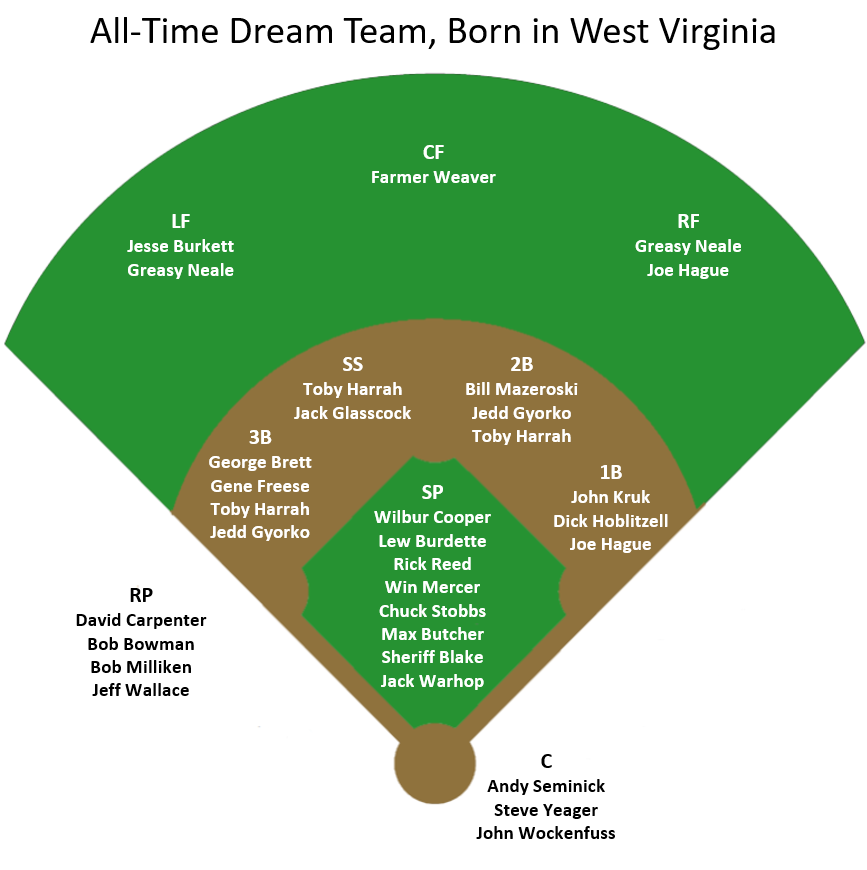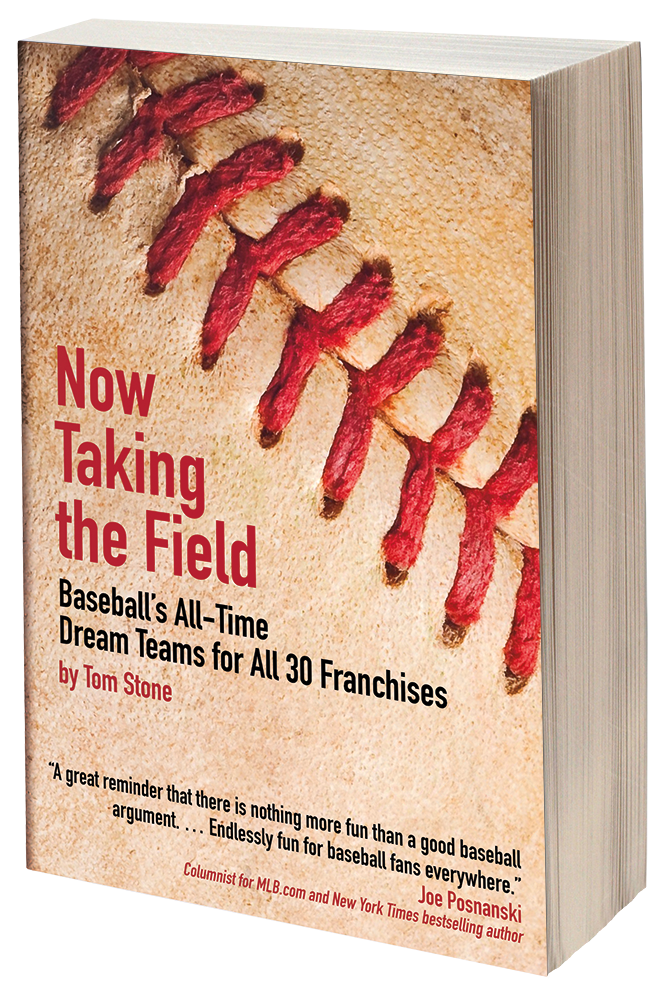West Virginia's Baseball All-Time Dream Team
What would a dream team roster look like for major league players born in West Virginia?
Issue #100
This is the tenth article in a series where I am creating all-time dream teams for players born in each of the fifty US states. I’ll be publishing each write-up on the anniversary date that the particular state joined the union. So far I’ve covered Maryland, Louisiana, Minnesota, South Carolina, Rhode Island, Wisconsin, Kentucky, Tennessee, and Arkansas.
Next up is West Virginia, which according to Wikipedia “was admitted to the Union on June 20, 1863, and was a key border state during the American Civil War. It was the only state to form by separating from a Confederate state, one of two states (along with Nevada) admitted to the Union during the Civil War, and the second state to separate from another state, after Maine separated from Massachusetts in 1820.”
Important caveat to what follows: I’m creating these all-time dream teams based on the birthplace data available at baseball-reference.com. I realize this might mean some players will appear for a state’s all-time dream that seems odd, e.g., a player who was born in one state but lived there only briefly, while then spending most of his youth, or especially critical years playing baseball in high school in another state. So that is an important caveat to the below dream team roster—and I’ll list the players that I know went to high school in a state other than West Virginia towards the end of this article.
Here is the all-time dream team I came up with for players born in West Virginia:
Like the other US State dream teams I’ve created so far, this one has a few Hall of Famers and other star players, but also some positions that are relatively lacking. The headliner here is 3B George Brett—though he only lived in West Virginia for two years and grew up and went to high school in California. The other two Hall of Famers on this roster are 19th century star LF Jesse Burkett and defensive whiz 2B Bill Mazeroski (who went to high school in Ohio, not West Virginia).
Other than Burkett, the outfield candidates were very weak. The best I could find were William “Farmer” Weaver (1888-94) as a CF and Alfred “Greasy” Neale (1916-24) who played both RF and LF. The infield was a bit stronger, with the aforementiond Brett and Mazeroski, two solid SS in Toby Harrah and Jack Glasscock, and two solid 1B in John Kruk and Dick Hoblitzell.
Starting lineups for this all-time dream team could look like this:
Against RHP:
Jesse Burkett LF (L)
Toby Harrah / Jack Glasscock SS (R)
George Brett 3B (L)
John Kruk 1B (L)
Dick Hoblitzell DH (L)
Andy Seminick C (R)
Bill Mazeroski 2B (R)
Greasy Neale RF (L)
Farmer Weaver CF (S)
Against LHP:
Jesse Burkett LF (L)
Toby Harrah / Jack Glasscock SS (R)
George Brett 3B (L)
Jedd Gyorko DH (R)
Andy Seminick C (R)
John Kruk 1B (L)
Bill Mazeroski 2B (R)
Greasy Neale RF (L)
Farmer Weaver CF (S)
Burkett and his .338 average and .415 OBP, plus 389 career stolen bases, is an outstanding leadoff hitter here. Harrah and Glasscock were both right-handed hitters, so I listed them as sharing the SS duties. Though I’ll note that Glasscock was born in 1857, so technically wasn’t born in West Virginia—he was born in the city of Wheeling, which became part of the separate state of West Virginia only in 1863 as described above.
There isn’t much real power on this roster, though I was able to get Jedd Gyorko, who had 30 HR in 2016 and hit 20+ in two other seasons, in the lineup as a DH against LHPs. Platooning with him is Hoblitzell, who played from 1908-1918 and so didn’t hit many HRs, but did have solid triples-power for that era, with six seasons of 10+.
Seminick had a little pop, hitting double-digit HRs 10 times, with a high of 24 in both 1949 and 1950. Bill Mazeroski hit double-digit HRs 7 times, with a high of 19 in 1958, the first of seven seasons in which he was an All-Star. And John Kruk was a lifetime .300 hitter with an impressive .397 OBP, and hit 20+ HR twice—though he didn’t hit LHP nearly as well as RHP, so I dropped him from the cleanup spot in the second lineup.
As for the pitchers, the ace of the staff here is Wilbur Cooper who pitched from 1912-26, mostly for the Pirates. He won 20+ games four times, and had two other seasons with 19 wins. After Cooper, the second best was Lew Burdette, who played most of his career for the Braves, and was an All-Star twice while earning some MVP consideration four times. How you rank the other SP that I included could be debated, but for the third spot I went with Rick Reed who was up and down between the minors and majors for a decade before finally making it with the Mets in his age-32 season in 1997, before being an All-Star in both 1998 and 2001.
The bullpen was really lacking in candidates, so I chose the four best I could I find. David Carpenter pitched for six teams across six seasons in the majors, but did end up with a 3.69 ERA and 104 ERA+.
To wrap up, here are the West Virginia-born players who I could determine went to high school in other states—and so might be more associated with those states than West Virginia—including of course a few mentioned earlier such as Brett and Mazeroski:
George Brett - California
Wilbur Cooper - Ohio
Joe Hague - Texas
Toby Harrah - Ohio
Dick Hoblitzell - Ohio
Bill Mazeroski - Ohio
Andy Seminick - Pennsylvania
Chuck Stobbs - Virginia
Jeff Wallace - Ohio
John Wockenfuss - Delaware
Steve Yeager - Ohio
What about the other direction—born elsewhere but went to high school in West Virginia? I could only find one notable player like that, Nick Swisher (2004-2015), who was born in Columbus, Ohio, but went to high school in Parkersburg, West Virginia. A RF who had nine seasons with 20+ HR, obviously he would be an upgrade over Greasy Neale and Joe Hague on the roster above. But this dream team would be much weaker overall if you subtracted all of the players (Brett, Cooper, Harrah, Mazeroski, Seminick, etc.) who grew up and went to high school elsewhere.
All data is from Baseball-Reference.com, and also their subscription service Stathead.com. If you are a big sports fan, be sure to check out the latest features at Stathead and the Sports Reference family of sites. The state map, flag, flower, and bird images are from Wikipedia.
Did you know? I wrote a book with the same title as this Substack newsletter / blog: Now Taking the Field: Baseball’s All-Time Dream Teams for All 30 Franchises. It was published in early 2019, by ACTA Sports, the publisher of the annual Bill James Handbook and other popular titles. You can learn more about it at www.NowTakingTheField.com, or buy directly at Amazon and other booksellers.






